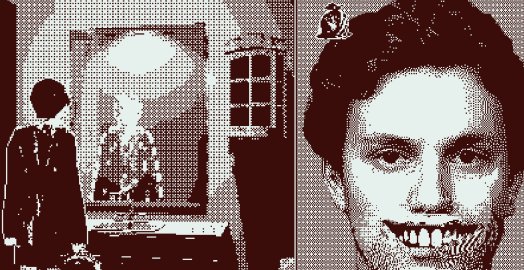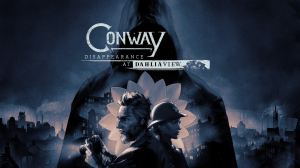Review for Who’s Lila?

There's no doubt about it: Who's Lila? is a very unusual game. That should not come as a surprise if you take even a casual glance at any of its screenshots, full of grotesquely misshapen faces and bleak 1-bit graphics. But even for a game that starts out by asking you to manipulate your character's face rather than choosing dialogue options, it somehow manages to get much, much weirder than that. Wearing its David Lynch inspirations heavily on its sleeve, Who's Lila? is a disturbing trip into nightmarish landscapes, cults and the supernatural, with some very fun and unexpected ARG (alternate reality) puzzle elements. It's a shame that halfway through, the oddness and inventiveness start to peter out and the experience gets repetitive, forcing you to replay scenes over and over to try and make any progress. But perhaps given the alarming things you'll end up witnessing ’til that point, maybe it’s just as well the game gives you a little break.
You play as Will, a bit of a loner and, it's fair to say, also a bit of a strange lad. One of the most popular girls at school, Tanya Kennedy, has been missing for several days and her friends are convinced that you're the last person to have seen her alive. Without yet knowing how you fit into it all, you will visit different locations, from your school to the burnt-down remains of a warehouse to a house party, to try to piece together what's happened to Tanya.
I say Will is a little unusual as he freely admits at the start that he finds it particularly hard to express emotions. It's never explained exactly why this is the case, whether he perhaps has a form of autism or some past trauma left him unable to easily intuit expressions and how to react in normal situations. But herein lies one of the game's fundamental mechanics. Whilst on the left-hand side of the screen you'll control Will moving about his environment in the third (and occasionally first) person, on the right side is a large close-up of Will's face. When you're chatting to people, instead of picking from a group of dialogue options, you'll instead have to select from a set of six facial expressions (scared, surprised, sad, etc.) to react with. To demonstrate your choice, you have to physically pull Will's face around (nudge the corners of his mouth up to make a smile, open his eyes wide to make a surprised face, for example) to form the expression you want. The game then uses a specifically trained face-recognizing neural network to interpret the expression you're making, and you can submit that as your given response.
Complicating matters, in the game’s normal mode you only have a short amount of time to form and submit your facial expression, and Will's face will change of its own accord to other expressions, meaning you have to fight your own face to convey the emotion you want. This can be quite difficult at times, especially if you have to display a few different expressions in one conversation. Thankfully, there is an easy mode you can select from the menu, which gives you a longer time to answer and also stops Will's face from moving on its own. Especially near the end of the game, when every expression counts, this was a very welcome addition, and can thankfully be changed whenever you want from the menu.
All in all, the facial expressions feel like more than just a gimmick – they really make sense for the character you're playing, and different expressions will unlock different dialogue paths and even endings (more on those later). Smile in a situation where your fellow speaker is frightened, and rather than coming across as friendly, you'll be noted as looking weird or scary. Similarly, look scared after someone's said something shocking, and you might come across as suspicious, or perhaps simply genuine. The expressions also add to the overall uneasiness of the experience. There's something really creepy about having to pull back parts of a character's face in an attempt to reveal an emotion within, especially when it's one you're never sure Will really quite shares.
Along with the easy mode, another quality-of-life touch is a hotspot highlighter (space bar) to help you navigate your environment more easily. Whilst most items can only be clicked to look at for a comment from the protagonist, some can be picked up and placed in your inventory to be used later. To travel to different locations, you can either type the names of places into a map, or select places you've been to or discovered from a list already displayed on it.
In keeping with the not-quite-real atmosphere of Who’s Lila?, some of the locations you'll visit will be in the past, as you try to build up to the day that Tanya disappeared for good. Be warned: one or two scenes you'll play through are decidedly dark and unpleasant – the one-bit graphics only adding to the feeling that you're watching some gritty, sparse snuff film shot on a low-budget camera. As an aside, you can unlock different-coloured palettes as you progress, though I found the original the easiest for seeing what was going on, so I didn't tend to stray too much from that.
The audio also lends a particularly menacing edge to Will's story, with warped synth swirling around in some of the more nightmarish locales, or softer chimes trying to restore calm in the school setting. Even here things aren't quite what they seem, however: enter a classroom only to somehow exit on a different floor, and the less said about the weird noises coming from the boiler room the better. It's as if David Lynch's Twin Peaks had an unholy child with Christopher Nolan's Memento – part disturbing and surreal gross-out, and partly a scattershot of memories and events that you have to fit together.
As you delve deeper into the story, you'll find it's not just Will's world that you'll need to comb for clues to go further; the game also asks you to search specific parts of the “real world” for more. For example, fake social media pages (set up in real life) and even at one stage a whole free DLC that you'll have to download and set up alongside the main game, which gives you new places and items to investigate. For the most part these AR elements are really fun and unexpected, though some of the puzzles surrounding them are very obscure – I needed a walkthrough to figure them out – and the DLC itself was quite fiddly to set up and get working with the game on too. Once it's up and running, though, it does add a very surprising and creative extra twist to the experience, again making you feel like you're stepping into uncharted territory, never knowing where the game is going to throw you next.
Who's Lila? has fifteen normal endings to unlock (and some secret ones you can't see in your achievements from the start), though some outcomes can be reached very quickly once you've already read parts of the dialogue once. You can also save at any point you want, meaning you can save just before a new part of the game is unlocked, in case you want to reload quickly from there rather than restarting the whole game. Each ending unlocks a tarot card associated with it, which you can discuss with the mysterious Detective Yu, a character also investigating the Tanya Kennedy case. I again had to start using a walkthrough about halfway through the game to unlock some of the more obscure endings, as after a while instead of leading you to new areas, the game requires you to replay past scenes with different specific combinations of facial expressions to achieve new paths and endings. This started to get quite repetitive – if I wasn't reviewing the game, I'm not sure whether I would have gone to the full effort of unlocking every outcome, as having to replay the same scene again and again soon started to feel quite tiring.
This is a shame because there's SO much to unpack with Who's Lila? that it really does deserve to have every ending prodded and poked out of it. (It'll probably take you at least six hours to get all of them, depending on how much you use a guide.) Unfortunately, whilst the alternate endings do add lots of replayability, along with many hidden secrets that players are still uncovering, they also leave the narrative feeling a little too open-ended and without a proper, definitive conclusion. The game itself acknowledges this, as a character reflects on how there's no canonical path in Will's misadventures – adding that all of them and none of them are real, with no one “true” ending.
In a game so full of surprises and sheer weirdness, this last surreal twist may prove to be one too many for some. But if you're willing to stick with Who's Lila?'s determination to confound and disrupt the usual status quo at every turn, you'll find one of the most challenging yet imaginative point-and-click adventure games of recent times. Just don't go into that boiler room, okay?
Our Verdict:
Like a David Lynch-inspired fever dream, Who’s Lila? refuses to be fit into a box, its bold graphics, creepy story, and peculiar facial expression mechanic making it one of the most unusual adventure games in recent history.



























